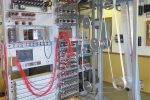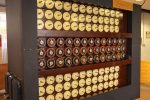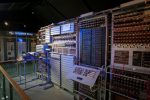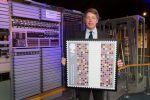Seventy-five years after the first Colossus was under construction, the original tools and tool bag of an engineer who maintained the code-breaking Colossus computers are on display alongside the working rebuild of the computer at The National Museum of Computing.
The family of the late Henry (John) Cane, a wartime General Post Office engineer, has donated his 1940s tool case and twenty tools. John was a member of one of the dedicated teams that built and kept the Colossus computers running almost continuously at Bletchley Park from February 1944 until the end of the Second World War.
Andrew Herbert, chair of TNMOC, said “The impact of this new technology changed history. By accelerating the deciphering of German High Command’s top-secret Lorenz-encrypted messages, the Colossus machines were instrumental in shortening the war by an estimated two years, thereby saving countless thousands of lives. The equipment marked the earliest stages in the development of our digital world.”
In December 1943, the first Colossus was being built and tested by Tommy Flowers and his ‘band of brothers’ at Dollis Hill, the laboratories of the General Post Office (now BT) in London. Flowers had taken the bold and unprecedented step of creating a machine with 1500 valves that could be programmed to run the code-breaking algorithms devised by the brilliant mathematician Bill Tutte.
The first Colossus was being built in December 1943 and is thought to have its first successful trial run at Dollis Hill on 8 December 1943. In December 1943 or perhaps January 1944, it was moved to Bletchley Park where it was reassembled and broke its first Lorenz message on 5 February 1944. These encrypted messages which previously might take weeks to decipher by hand could then be broken in a few hours.
Phil Hayes, chief engineer who maintains the Colossus painstakingly rebuilt by the late Tony Sale and his team at TNMOC, said, “I use tools like John Cane’s almost every today to keep the Colossus rebuild running, but these originals are very precious. Although they were designed for use in Strowger analogue telephone exchanges, they became critical to the war effort because Tommy Flowers, a telephone engineer by training, built Colossus mostly with telecommunications components — that was the technology available to him.”

“My favourite is a specialist 28-inch long screwdriver with a sleeve that is used on the plug boards and lamp strips. We are very grateful to the Cane family for their donation.”
By the end of the war, ten Colossus machines were kept running around the clock by teams of engineers, using tools like those of John Cane. Shifts of young Wrens would operate the Colossus machines and pass the Lorenz wheel settings discovered to codebreakers who could then decipher the top-secret enemy messages.
In 2019, the museum plans to hold several events to mark the 75th anniversary of Colossus. On 5 February 2019, it will be 75 years since Colossus attacking its first Lorenz message. In April 2019, the museum plans to celebrate the completion of reconstruction of the Heath Robinson machine, the predecessor and inspiration of Colossus. The month of May marks the 75th anniversary of the arrival of the second phase of Colossus machines (Colossus Mark IIs) which arrived in time to provide vital intelligence about enemy plans at the time of the D-Day landings.




















